Research on the Spatial-Temporal Evolution and Driving Mechanism of Coupling Coordination among Digital-Tourism-Environment in the Yellow River Basin
Abstract
1. Introduction
2. Coordination Mechanism
2.1. The Ecological Environment and the Digital Economy
2.2. The Ecological Environment and the Tourism Industry
2.3. The Digital Economy and the Tourism Industry
3. Index Measurement, Data Sources, and Research Methods
3.1. Study Area
3.2. Index Selection and Data Sources
- (1)
- (2)
- Following the structure outlined in the Report on China’s Sustainable Development Strategy by the Chinese Academy of Sciences [56], the ecological environment indicators are categorized into three elements: ecological environment elements, ecological environment pressures, and ecological environment protection.
- (3)
3.3. Research Propositions
3.4. Research Methods
3.4.1. The Coupling Coordination Degree Model
3.4.2. Calculation of Nuclear Density
3.4.3. Analysis of Spatial Autocorrelation
3.4.4. Tobit Model
4. Spatial-Temporal Features of DTE System Coupling Coordination Degree
4.1. Analysis of the Comprehensive Development Levels of the Three Systems
4.2. Temporal Evolution of DTE System Coupling Coordination
4.3. Spatial Evolution of DTE System Coupling Coordination
5. Driving Factors of DTE System Coupling Coordination Degree
5.1. The Economic Pulling Force
5.2. The Internal Driving Force
5.3. Government Regulatory Authority
5.4. The Technological Impetus Force
6. Discussion
7. Conclusions
7.1. Findings
7.2. Practical Inspiration
7.3. Limitations and Future Research
Author Contributions
Funding
Institutional Review Board Statement
Informed Consent Statement
Data Availability Statement
Conflicts of Interest
References
- The United Nations. 17 Goals to Transform Our World. Available online: https://www.un.org/sustainabledevelopment/zh/ (accessed on 13 May 2024).
- WCED. Our Common Future; Oxford University Press: Oxford, UK, 1987; pp. 34–44. [Google Scholar]
- Zhou, C.; Zhang, X.H.; Zhang, Q.; Liu, B.H. The construction of “Five in One” comprehensive evaluation system and spatial difference in the Yellow River Basin. J. Desert Res. 2021, 41, 1–11. [Google Scholar] [CrossRef]
- Jin, F.J.; Ma, L.; Xu, D. Environmental stress and optimized path of industrial development in the Yellow River Basin. Resour. Sci. 2020, 42, 127–136. [Google Scholar] [CrossRef]
- Wang, Z.F.; Li, J.Y. Verify and Study the Coupling Coordination Development and the Interactive Stress between Tourism and Eco-environment in the Yellow River Basin. Resour. Environ. Yangtze Basin 2022, 31, 447–460. [Google Scholar]
- Sheng, Y.C.; Xu, S.; Li, Q.; Xu, L.L. Environmental regulation enabling industrial structure upgrading in the Yellow River Basin: Supply optimization or demand driven. Prog. Geogr. 2023, 42, 1039–1054. [Google Scholar] [CrossRef]
- Wang, K.; Yi, J.X.; Lei, Y.Q. The Yellow River basin, abundant tour resources. People’s Dly. 2021, 10, 27. [Google Scholar] [CrossRef]
- Adedoyin, F.F.; Agboola, P.O.; Ozturk, I.; Bekun, F.V.; Agboola, M.O. Environmental consequences of economic complexities in the EU amidst a booming tourism industry: Accounting for the role of brexit and other crisis events. J. Clean. Prod. 2021, 305, 127117. [Google Scholar] [CrossRef]
- Tan, L.; Yang, Z.; Irfan, M.; Ding, C.J.; Hu, M.; Hu, J. Toward low-carbon sustainable development: Exploring the impact of digital economy development and industrial restructuring. Bus. Strategy Environ. 2023, 33, 2159–2172. [Google Scholar] [CrossRef]
- Wei, L.; Ullah, S. International tourism, digital infrastructure, and CO2 emissions: Fresh evidence from panel quantile regression approach. Environ. Sci. Pollut. Res. 2022, 29, 36273–36280. [Google Scholar] [CrossRef] [PubMed]
- Tian, L.; Sun, F.; Zhang, Z.; Zhang, S. Coupling coordination and driving mechanism of tourism industry, urbanization, and ecological environment: A case study of Shandong, China. Environ. Dev. Sustain. 2023, 1–22. [Google Scholar] [CrossRef]
- Zhao, S.H.; Bai, M.; Ruan, M.Z.; Qian, H. Spatio-temporal evolution characteristics and obstacle factors of coordinated development of tourism resources and ecological security in Yunnan Province. Sci. Geogr. Sin. 2021, 41, 493–503. [Google Scholar] [CrossRef]
- Qiang, M.; Wu, Y.; Yang, Y.; Shen, M. How air pollution affects tourism revenue: Evidence from China. Curr. Issues Tour. 2024, 1–15. [Google Scholar] [CrossRef]
- Dong, D.X.; Xu, X.W.; Wong, Y.F. Estimating the impact of air pollution on inbound tourism in China: An analysis based on regression discontinuity design. Sustainability 2019, 11, 1682. [Google Scholar] [CrossRef]
- Ali, Q.; Yaseen, M.R.; Anwar, S.; Makhdum, M.S.A.; Khan, M.T.I. The impact of tourism, renewable energy, and economic growth on ecological footprint and natural resources: A panel data analysis. Resour. Policy 2021, 74, 102365. [Google Scholar] [CrossRef]
- Porto, N.; Ciaschi, M. Reformulating the tourism-extended environmental Kuznets curve: A quantile regression analysis under environmental legal conditions. Tour. Econ. 2021, 27, 991–1014. [Google Scholar] [CrossRef]
- Porto, N.; Pitetti, D.A.; Ciaschi, M.A. worldwide tourism-extended Environmental Kuznets Curve. New approaches in a comparative analysis. J. Sustain. Tour. 2023, 31, 2100–2118. [Google Scholar] [CrossRef]
- Wang, L.; Zhou, X.H. Research on the Mechanism and Path of Digitally-empowered Development of Tourism Economy: Quantity or Quality? Zhejiang Soc. Sci. 2023, 6, 26–37. [Google Scholar] [CrossRef]
- Tang, R. Can digital economy improve tourism economic resilience? Evidence from China. Tour. Econ. 2023. [Google Scholar] [CrossRef]
- Wang, W.G.; Wang, Y.L.; Fan, D. Effects and mechanisms of the digital economy for carbon emission reduction. China Environ. Sci. 2023, 43, 4437–4448. [Google Scholar] [CrossRef]
- Wang, S.L. Digital economy development for urban carbon emissions: ‘accelerator’ or ‘speed bump’? China Popul. Resour. Environ. 2023, 33, 11–22. [Google Scholar]
- Yao, W.; Sun, Z. The Impact of the Digital Economy on High-Quality Development of Agriculture: A China Case Study. Sustainability 2023, 15, 5745. [Google Scholar] [CrossRef]
- He, X.H.; Ping, Q.Y. Does digital technology promote the sustainable development of the marine equipment manufacturing industry in China? Mar. Policy 2022, 136, 104868. [Google Scholar] [CrossRef]
- Su, Z.; Zheng, Y.H.; Guo, L. Impact of the digital economy on the carbon efficiency of the tourism industry and its threshold effect. China Popul. Resour. Environ. 2023, 33, 69–79. [Google Scholar]
- Zhang, J.; Shang, Y. The Influence and Mechanism of Digital Economy on the Development of the Tourism Service Trade—Analysis of the Mediating Effect of Carbon Emissions under the Background of COP26. Sustainability 2022, 14, 13414. [Google Scholar] [CrossRef]
- Wang, Y.; Zhang, X.F.; Lei, S.Z. An empirical test of the coupling coordination degree of digital economy, industrial development and ecological environment in the Yellow River Basin. Stat. Decis. 2024, 40, 108–113. [Google Scholar] [CrossRef]
- Geng, N.N.; Shao, X.Y. Research on Coupling Coordination of Ecological Environment-Tourism Industry-Urbanization in the Yellow River Basin. Econ. Probl. 2022, 3, 13–19. [Google Scholar] [CrossRef]
- Ma, H.T.; Lou, J.J. Spatio-temporal differentiation and influencing factors of economy-environment-tourism coupling coordination in the Yellow River Basin. Soc. Sci. 2021, 12, 94–99. [Google Scholar]
- Pan, J. Study on the coupling and coordination of high-quality development and ecological protection of urban agglomerations in the Yellow River Basin. Stat. Decis. 2023, 39, 113–117. [Google Scholar] [CrossRef]
- Li, L.S.; Zhao, H.B.; Guo, F.Y.; Wang, Y. High-quality development spatio-temporal evolution of industry in urban agglomeration of the Yellow River Basin. Sci. Geogr. Sin. 2021, 41, 17511762. [Google Scholar] [CrossRef]
- Guo, H.; Hu, C.Y. Ecological Environmental Protection and High-quality Industrial Economic Development in the Yellow River Basin: Coupled Measurement and Spatio-temporal Evolution. Ningxia Soc. Sci. 2022, 06, 132–142. [Google Scholar]
- Han, Y.; Pan, C.; Jin, F.J.; Ma, L. Evolution and influencing factors of the spatial pattern of digital industry in the Yellow River Basin. Resour. Sci. 2024, 46, 488–504. [Google Scholar] [CrossRef]
- Hao, Z.J.; Wen, Q.; Shi, L.N.; Wu, X.Y.; D, J.M. Spatial Network Analysis of Coupling Coordination Between Social Economy and Eco-Environment in Yellow River Basin Urban Agglomerations. Econ. Geogr. 2023, 43, 181–191. [Google Scholar] [CrossRef]
- Ren, B.P.; Du, Y.X. Coupling coordination of economic growth, industrial development and ecology in the Yellow River Basin. China Popul. Resour. Environ. 2021, 31, 119–129. [Google Scholar]
- Liu, L.K.; Liang, L.T.; Gao, P.; Fan, C.S.; Wang, H.H.; Wang, H. Coupling relationship and interactive response between ecological protection and high-quality development in the Yellow River Basin. J. Nat. Resour. 2021, 36, 176–195. [Google Scholar] [CrossRef]
- Yun, X.P. Coupling Coordination Measurement and Interactive Coercing Verification Between Urbanization and Eco-Environment in the Yellow River Basin. Econ. Probl. 2022, 8, 86–95. [Google Scholar] [CrossRef]
- Zhang, S.H.; Sun, Y.F. Impact of new infrastructure construction on regional innovation-ecology-economy coupling coordination: Tests based on spatial spillover effects and transmission mechanisms. China Popul. Resour. Environ. 2023, 33, 187–198. [Google Scholar]
- Du, W.; Li, M. Can environmental regulation promote the governance of excess capacity in China’s energy sector? The market exit of zombie enterprises. J. Clean. Prod. 2019, 207, 306–316. [Google Scholar] [CrossRef]
- Bastida, L.; Cohen, J.J.; Kollmann, A.; Moya, A.; Reichl, J. Exploring the role of ICT on household behavioral energy efficiency to mitigate global warming. Renew. Sustain. Energy Rev. 2019, 103, 455–462. [Google Scholar] [CrossRef]
- Ren, S.; Liu, Z.; Hanbayev, R.Z.; Du, M. Does Internet Development Put Pressure on Energy-Saving Potential for Environmental Sustainability? Evidence from China. J. Econ. Anal. 2022, 1, 5. [Google Scholar] [CrossRef]
- Sun, G.; Liu, Y.; Qian, Q.; He, Y.; Shi, Y.; Zhu, Y. Environmental regulation and tourism industry development: Evidence from China. Environ. Sci. Pollut. Res. 2023, 30, 81531–81549. [Google Scholar] [CrossRef]
- Ehigiamusoe, K.U.; Shahbaz, M.; Vo, X.V. How Does Globalization Influence the Impact of Tourism on Carbon Emissions and Ecological Footprint? Evidence from African Countries. J. Travel Res. 2023, 62, 1010–1032. [Google Scholar] [CrossRef]
- Feng, X.X. The Correlation between Universal Tourism and Regional Green Development. Reform 2018, 2, 122–131. [Google Scholar]
- Roudi, S.; Arasli, H.; Akadiri, S.S. New insights into an old issue-examining the influence of tourism on economic growth: Evidence from selected small island developing states. Curr. Issues Tour. 2018, 22, 1280–1300. [Google Scholar] [CrossRef]
- Navío-Marco, J.; Ruiz-Gómez, L.M.; Sevilla-Sevilla, C. Progress in information technology and tourism management: 30 years on and 20 years after the internet-Revisiting Buhalis & Law’s landmark study about eTourism. Tour. Manag. 2018, 69, 460–470. [Google Scholar]
- Li, X.H. New Features and the Formation Mechanism of New Growth Drivers of Digital Economy. Reform 2019, 11, 40–51. [Google Scholar]
- Anser, M.K.; Adeleye, B.N.; Tabash, M.I.; Tiwari, A.K. Services trade–ICT–tourism nexus in selected Asian countries: New evidence from panel data techniques. Curr. Issues Tour. 2022, 25, 2388–2403. [Google Scholar] [CrossRef]
- Pencarelli, T. The digital revolution in the travel and tourism industry. Inf. Technol. Tour. 2020, 22, 455–476. [Google Scholar] [CrossRef]
- Hateftabar, F. Analyzing the adoption of online tourism purchases: Effects of perceived tourism value and personal innovativeness. Curr. Issues Tour. 2022, 26, 1861–1877. [Google Scholar] [CrossRef]
- Wang, J.Q.; Nghiem, X.H.; Jabeen, F.; Luqman, A.; Song, M. Integrated development of digital and energy industries: Paving the way for carbon emission reduction. Technol. Forecast. Soc. Chang. 2023, 187, 122236. [Google Scholar] [CrossRef]
- Li, Z.D.; Huang, C.Y.; Ma, Y.B. Research on Regional Differences and Distribution Dynamics of Ecological Environment Level in the Yellow River Basin Empirical Analysis Based on Strong Sustainable Development Theory. J. Henan Norm. Univ. (Philos. Soc. Sci.) 2024, 51, 39–45. [Google Scholar] [CrossRef]
- Zhou, L.; Zhang, X.H.; Zhou, C.; Jin, Y.T.; Lv, S.S. A systematic evaluation of high-quality tourism development in provinces along the Yellow River. J. Desert Res. 2023, 43, 142–150. [Google Scholar] [CrossRef]
- Wang, J.; Lyu, D.S. Can Digital Economy Promote High-quality Development of the Yellow River Basin: A Study from the Perspective of Industrial Structure Upgrading. J. Northwest Univ. (Philos. Soc. Sci. Ed.) 2022, 52, 120–136. [Google Scholar] [CrossRef]
- Hou, Y.; Yang, M.; Li, Y. Coordinated effect of green expansion and carbon reduction: Evidence from sustainable development of resource-based cities in China. J. Environ. Manag. 2024, 349, 119534. [Google Scholar] [CrossRef] [PubMed]
- Central Government of the People’s Republic of China. National Plan for Sustainable Development of Resource-Based Cities (2013–2020). Available online: https://www.gov.cn/zhuanti/2013-12/03/content_2609341.htm (accessed on 13 May 2024).
- Sustainable Development Research Group, Chinese Academy of Sciences. 2000 China Sustainable Development Strategy Report; Science Press: Beijing, China, 2000. [Google Scholar]
- Ma, B.B.; Dou, Y.Y.; He, S.Q.; Zhang, A.X.; Yu, M.; Liu, D. Spatiotemporal Characteristics and Driving Mechanisms of the Integration Development of Digital Economy and Tourism Industry in China. Econ. Geogr. 2023, 43, 192–201. [Google Scholar] [CrossRef]
- Han, X.; Liu, X.M.; Liu, W.T.; Yu, W.L. Spatio-temporal Characteristics of the Coupling Coordinating Relationship BetweenGreen Finance and Economic High-quality Development in the Yellow River Basin and Its Driving Factors. Econ. Geogr. 2023, 43, 121–130. [Google Scholar]
- Li, J.S.; Sun, W.; Yu, J.H. Change and regional differences of production-living-ecological space in the Yellow River Basin: Based on comparative analysis of resource-based and non-resource-based cities. Resour. Sci. 2020, 42, 2285–2299. [Google Scholar] [CrossRef]
- Dong, J.F.; Wu, R.W.; Zhao, Y.F. Spatial-temporal evolution and driving force analysis of eco-environmental quality in Yellow River Basin, China. J. Hydroecol. 2024, 45, 60–69. [Google Scholar] [CrossRef]
- Zhang, J.X.; Gu, Y.X.; Shen, J.Q.; Zhang, M.Q.; Cong, M. Analysis of Spatiotemporal Changes and Driving Factors of Ecological Environment Quality in the Yellow River Basin. Environ. Sci. 2024, 1–23. [Google Scholar] [CrossRef]
- Ray, R.L.; Singh, V.P.; Singh, S.K.; Acharya, B.S.; He, Y. What is the impact of COVID-19 pandemic on global carbon emissions? Sci. Total Environ. 2022, 816, 151503. [Google Scholar] [CrossRef]
- Lin, W.K.; Hu, H.S.; Xu, G.L.; Lin, W.M. An Analysis on the Regime Division and Dynamic Change of the Tourism Consumption Cycle of Urban and Rural Residents in China. Tour. Sci. 2020, 34, 62–79. [Google Scholar] [CrossRef]
- Zhang, Z.; Qin, J.; Luo, L.; Feng, Y. Research on the Evaluation of Coordinated Development of Tourism–Economy–Ecological Environment along the Silk Road Economic Belt. Sustainability 2022, 14, 13838. [Google Scholar] [CrossRef]
- Meng, G.; Wang, K.Y.; Wang, F.Y.; Dong, Y.J. Analysis of the tourism-economy-ecology coupling coordination and high-quality development path in karst Guizhou Province, China. Ecol. Indic. 2023, 154, 110858. [Google Scholar] [CrossRef]
- Mao, N.; Sun, W.Z.; Yang, Y.J.; Liu, Z. Transportation Infrastructure Construction and Enterprise Digital Transformation—An Empirical Study on China’s High-speed Railway. J. Quant. Technol. Econ. 2022, 39, 47–67. [Google Scholar]
- Song, R.; Xu, Y.W.; Shi, R.Y. Efficiency evaluation and driving factors analysis of tourism industry in the Yellow River basin—An empirical study based on DEA method and spatial Dubin model. China Soft Sci. 2022, 11, 26–36. [Google Scholar]
- Sun, C.W.; Luo, Y.; Yao, X. The Effects of Transportation Infrastructure on Air Quality: Evidence from Empirical Analysis in China. Econ. Res. J. 2019, 54, 136–151. [Google Scholar]
- Shen, K.R.; Shi, M.Y. Providing Strong Support for Chinese Path to Modernization by Building a Country with Great Transportation Strength. China Rev. Political Econ. 2023, 14, 22–41. [Google Scholar]
- Li, H.; Zou, Q. Environmental Regulations, Resource Endowments and Urban Industry Transformation: Comparative Analysis of Resource-based and Non-resource-based Cities. Econ. Res. J. 2018, 53, 182–198. [Google Scholar]
- Xi, Z.X.; Ma, L.; Jin, F.J.; Wang, N.; Liu, Z. Spatiotemporal characteristics, types, and paths of industrial transformation in typical resource-based cities in the Yellow River Basin. Resour. Sci. 2023, 45, 1977–1991. [Google Scholar] [CrossRef]
- Guo, A.J.; Zhang, C.B. How Does the Digital Economy Affect the Intensity of Carbon Emissions—Based on the Dual Perspectives of Industrial Structure Upgrading and Rationalization. Sci. Sci. Manag. S. T. 2023, 1–28. Available online: http://kns.cnki.net/kcms/detail/12.1117.G3.20231130.1033.004.html (accessed on 13 May 2024).
- China Tourism Academy. Annual Report on China’s Domestic Tourism Development 2021; Tourism Education Press: Beijing, China, 2022. [Google Scholar]
- Lv, W.; Liu, X.Q. Review and Outlook of Proactive Fiscal Policy. Public Financ. Res. 2024, 01, 16–28. [Google Scholar]
- Xing, L.; Chen, L. Proactive Fiscal Policy: The New Logic of China’s Practice. Soc. Sci. China 2023, 2, 57–77+205–206. [Google Scholar]
- Zhang, Z.; Gong, J.; Ma, H.; Zhang, J. The Spatial and Temporal Evolution and Influencing Factors of the Coupling and Coordinated Development of Basic Public Services, Urbanization, and Tourism in China. Sustainability 2023, 15, 11753. [Google Scholar] [CrossRef]
- Pei, X.; Yuan, S.; Luo, S. Spatio-Temporal Coupling and Obstruction Factors Between Green Development and Digital Economy in Yangtze River Economic Belt. Resour. Environ. Yangtze Basin 2023, 32, 2045–2059. [Google Scholar]
- Wang, J.W.; Wang, Q.X.; Feng, L. Coordination pattern and driving mechanism of digital economy and high-quality tourism development in China. Sci. Geogr. Sin. 2024, 44, 130–139. [Google Scholar] [CrossRef]
- Sun, K.; Zhang, L. Research on Government Competition, Fiscal Pressure and Its Regulation—From the Perspective of Local Government Fiscal Expenditure Bias. Econ. Theory Bus. Manag. 2020, 5, 22–34. [Google Scholar]
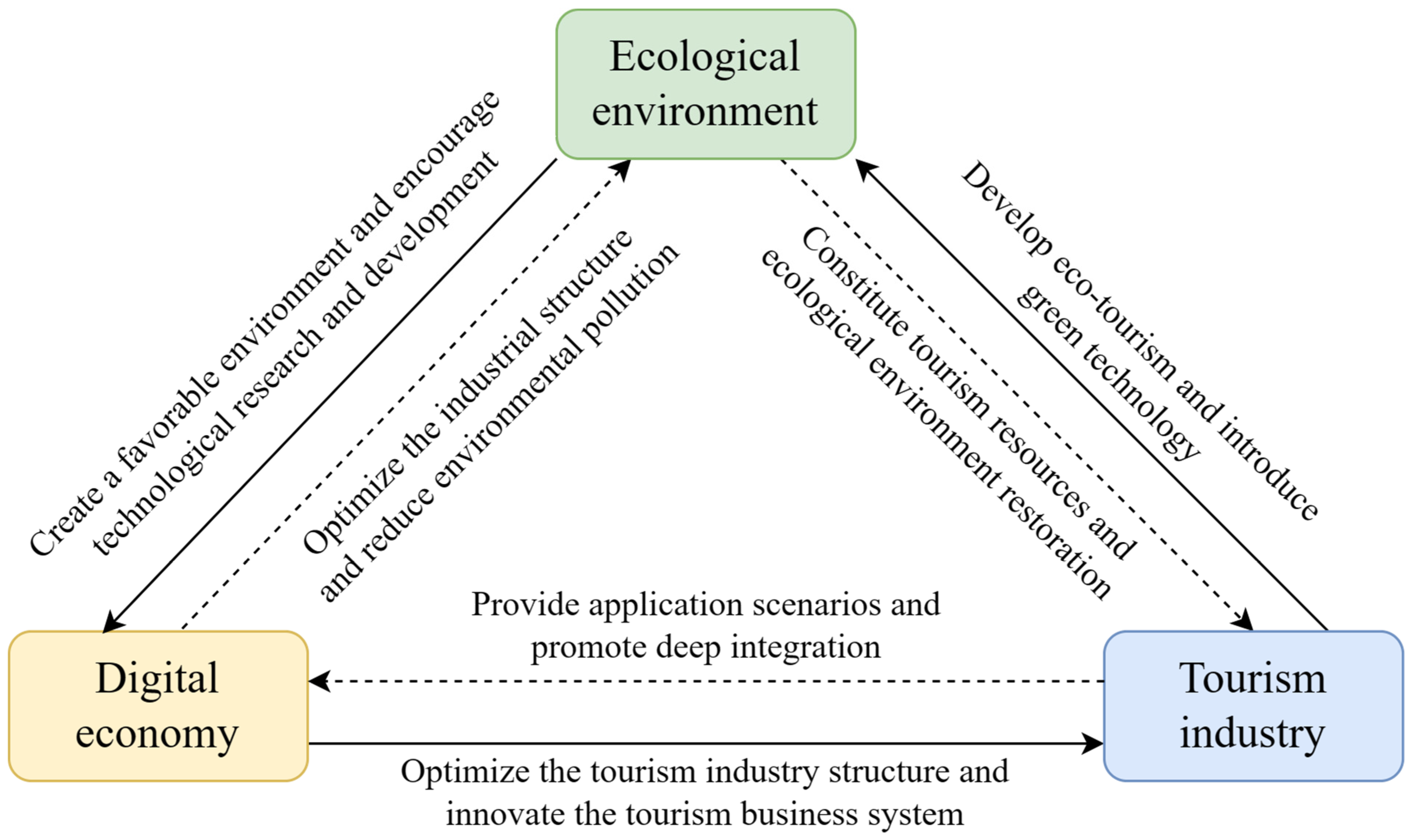
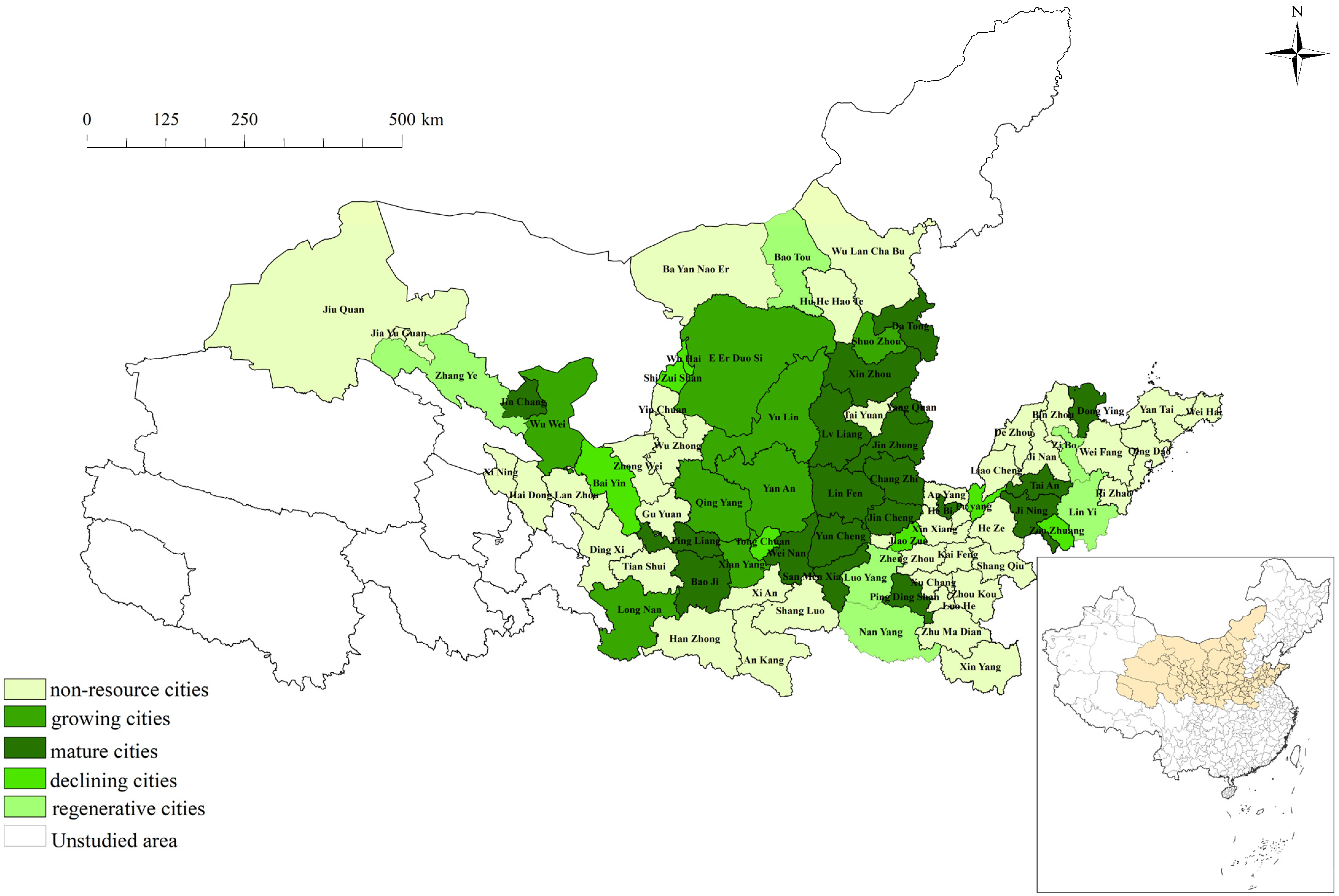
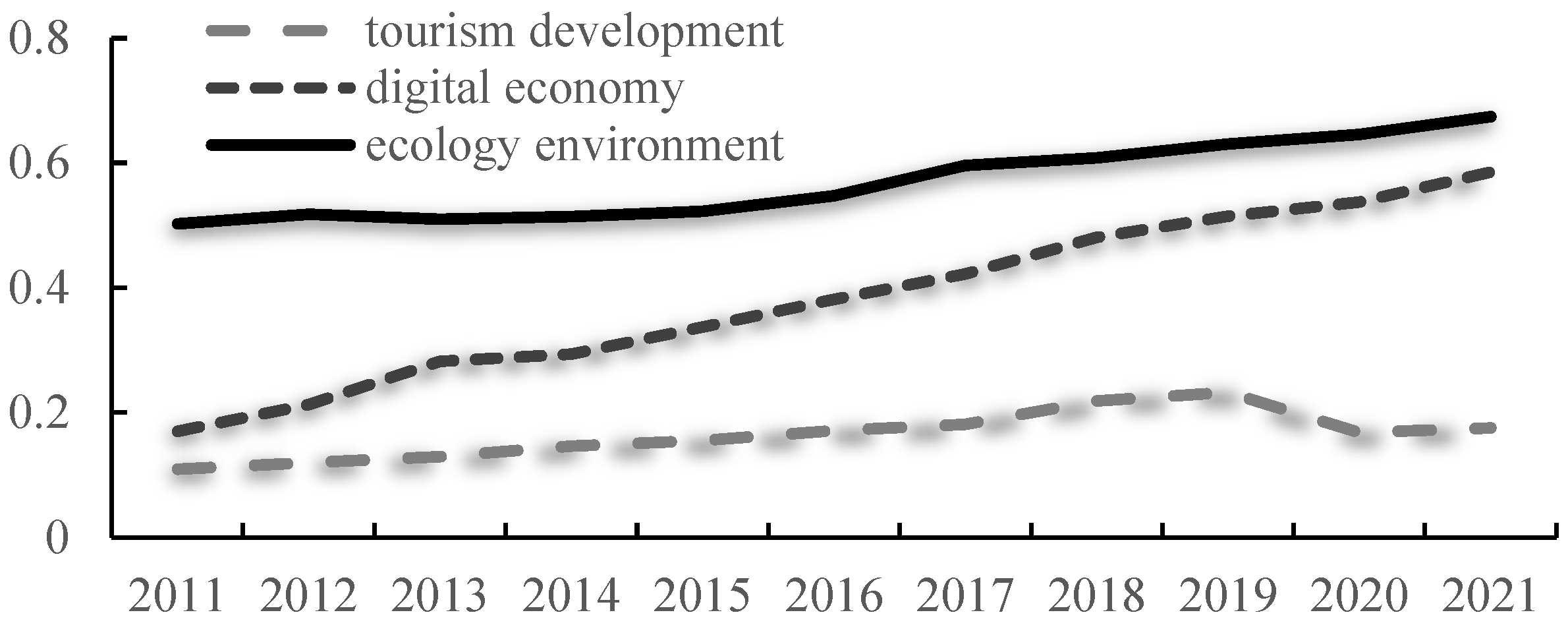
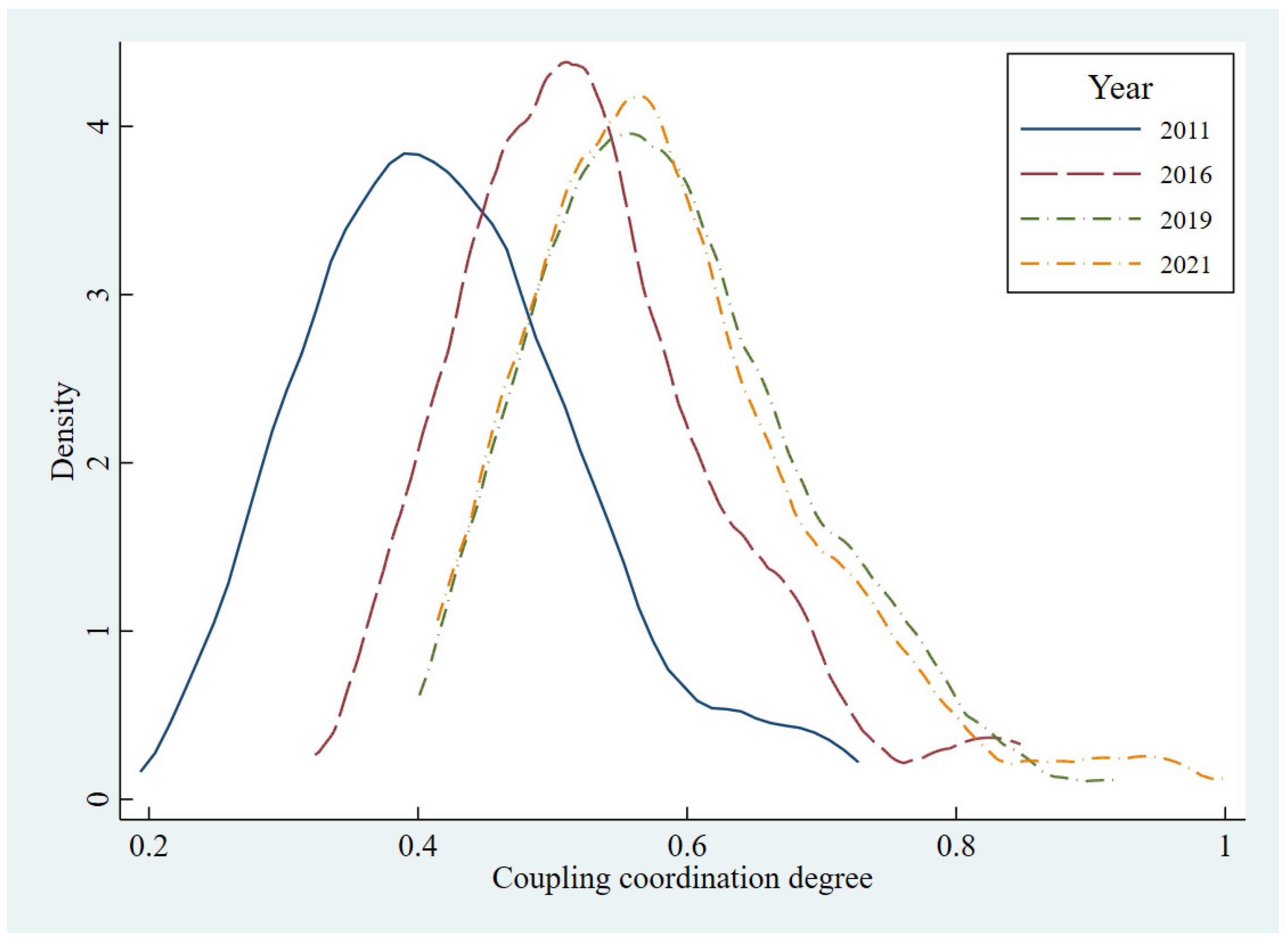
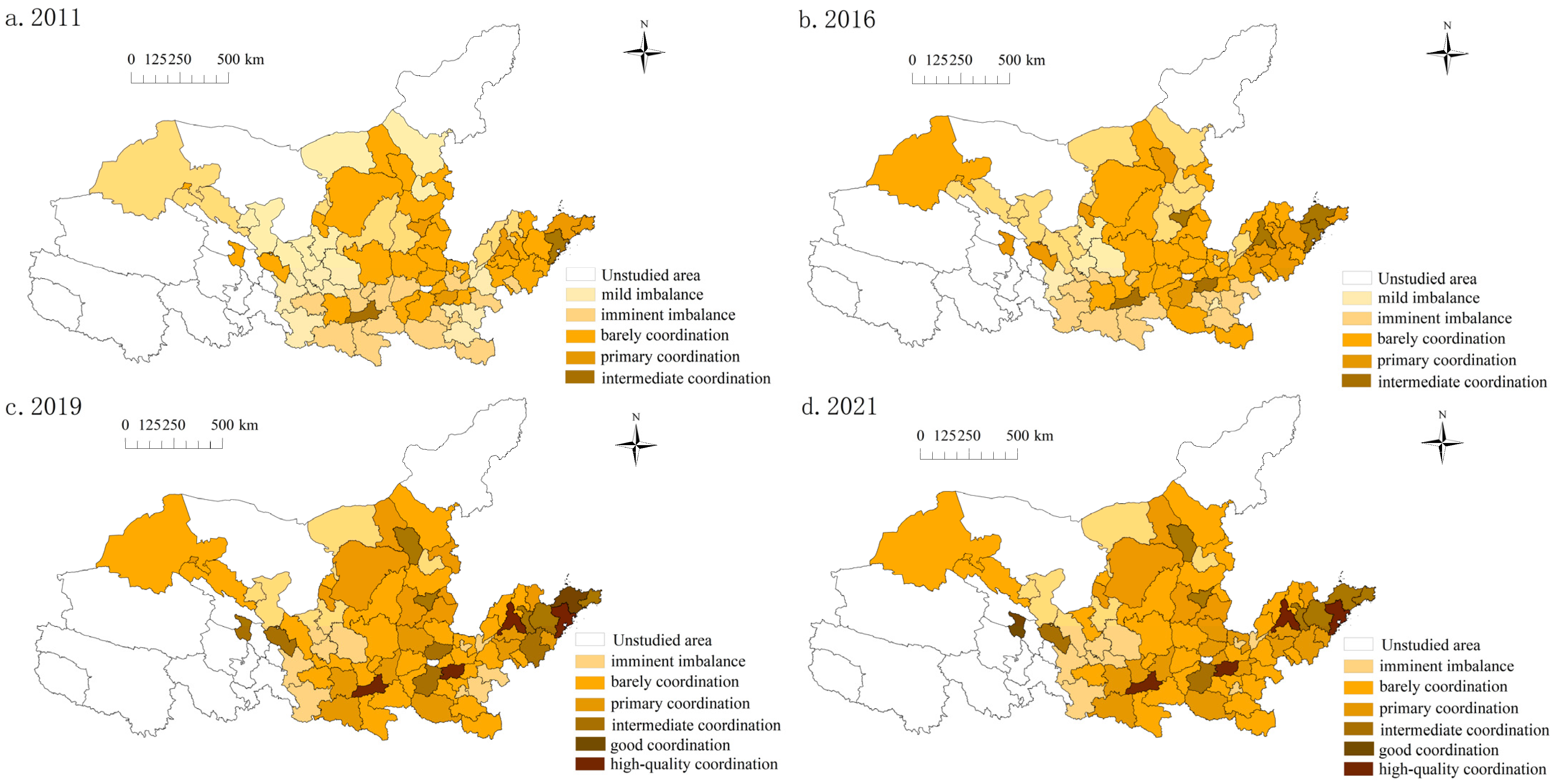
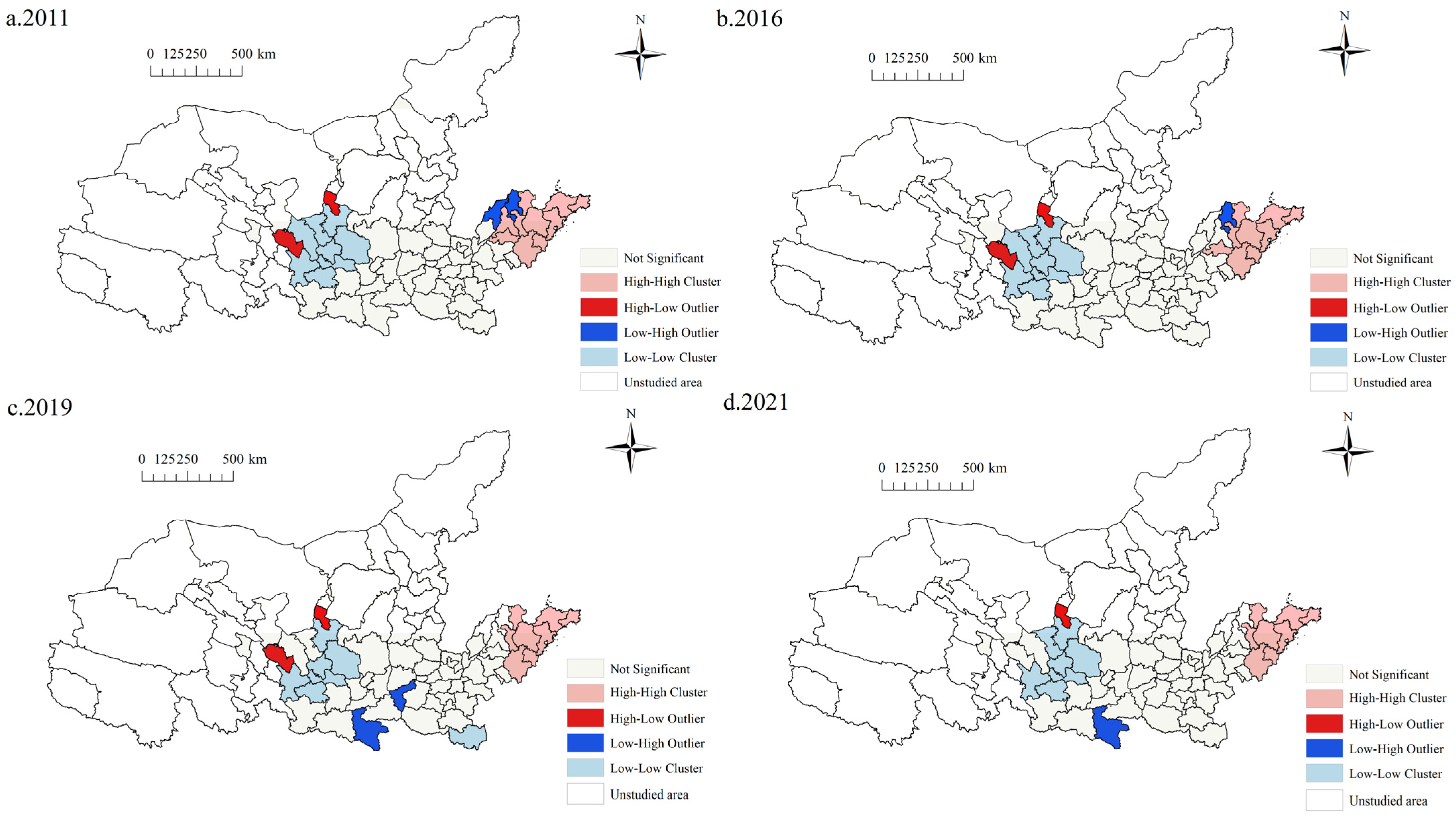
| Target Layer | Element Layer | Index Layer | Nature | Weight |
|---|---|---|---|---|
| Tourism industry system | Development elements | Number of employees in the tourism industry | + | 0.059 |
| Number of star-rated hotels | + | 0.032 | ||
| Number of travel agencies | + | 0.062 | ||
| Density of tourist attractions | + | 0.067 | ||
| Number of enterprises in accommodation and catering industries | + | 0.083 | ||
| market scale | Number of domestic tourists | + | 0.047 | |
| Inbound tourist arrivals | + | 0.295 | ||
| Total number of tourists | + | 0.047 | ||
| economic level | Domestic tourism revenue | + | 0.060 | |
| Tourism foreign exchange earnings | + | 0.190 | ||
| Gross tourism income | + | 0.057 | ||
| Ecological protection system | Environmental element | Per capita green park area | + | 0.058 |
| Green coverage rate | + | 0.260 | ||
| Water resources content | + | 0.484 | ||
| Environmental pressure | Industrial wastewater discharge | - | 0.009 | |
| Carbon emissions | - | 0.105 | ||
| Energy consumption | - | 0.004 | ||
| Environmental governance | Comprehensive utilization rate of industrial waste | + | 0.058 | |
| Centralized treatment rate of sewage treatment plant | + | 0.009 | ||
| Domestic waste disposal rate | + | 0.012 | ||
| Digital economic system | Digital infrastructure | Internet broadband access ports | + | 0.122 |
| Number of Domains | + | 0.197 | ||
| Optical cable line length | + | 0.115 | ||
| Digital industry development | E-commerce sales | + | 0.185 | |
| Employment in information transmission, software, and information technology services | + | 0.190 | ||
| Total volume of telecommunication service | + | 0.103 | ||
| Digital technology application | Mobile phone penetration | + | 0.020 | |
| Internet broadband penetration rate | + | 0.050 | ||
| Digital Financial Inclusion Index | + | 0.018 |
| Year | Whole Basin | Coordination Grade | Resource Cities | Non-Resource Cities | ||||
|---|---|---|---|---|---|---|---|---|
| Total | Growth | Maturity | Decline | Regeneration | ||||
| 2011 | 0.429 | imminent imbalance recession | 0.418 | 0.372 | 0.429 | 0.385 | 0.480 | 0.442 |
| 2012 | 0.456 | imminent imbalance recession | 0.442 | 0.393 | 0.453 | 0.410 | 0.512 | 0.471 |
| 2013 | 0.483 | imminent imbalance recession | 0.469 | 0.424 | 0.478 | 0.430 | 0.548 | 0.498 |
| 2014 | 0.498 | imminent imbalance recession | 0.479 | 0.443 | 0.488 | 0.432 | 0.556 | 0.519 |
| 2015 | 0.517 | marginal coordination development | 0.497 | 0.464 | 0.503 | 0.452 | 0.573 | 0.539 |
| 2016 | 0.540 | marginal coordination development | 0.518 | 0.474 | 0.528 | 0.471 | 0.601 | 0.566 |
| 2017 | 0.565 | marginal coordination development | 0.542 | 0.494 | 0.552 | 0.488 | 0.639 | 0.590 |
| 2018 | 0.593 | marginal coordination development | 0.571 | 0.521 | 0.583 | 0.506 | 0.672 | 0.618 |
| 2019 | 0.608 | primary coordination development | 0.584 | 0.538 | 0.598 | 0.520 | 0.675 | 0.635 |
| 2020 | 0.583 | marginal coordination development | 0.557 | 0.516 | 0.566 | 0.500 | 0.648 | 0.613 |
| 2021 | 0.599 | marginal coordination development | 0.572 | 0.538 | 0.580 | 0.512 | 0.661 | 0.632 |
| Year | 2011 | 2012 | 2013 | 2014 | 2015 | 2016 | 2017 | 2018 | 2019 | 2020 | 2021 |
|---|---|---|---|---|---|---|---|---|---|---|---|
| index | 0.098 | 0.085 | 0.099 | 0.060 | 0.066 | 0.069 | 0.064 | 0.048 | 0.031 | 0.034 | 0.035 |
| p | 0.000 | 0.000 | 0.000 | 0.000 | 0.000 | 0.000 | 0.000 | 0.002 | 0.026 | 0.017 | 0.014 |
| Variable | (1) | (2) | (3) |
|---|---|---|---|
| Whole Basin | Resource City | Non-Resource City | |
| Per capita GDP (gdp) | 0.132 *** | 0.0966 *** | 0.150 *** |
| (0.0117) | (0.0157) | (0.0177) | |
| Industrial structure (indus) | 0.0382 *** | 0.0432 *** | 0.0286 * |
| (0.00806) | (0.0100) | (0.0127) | |
| Market demand (mar) | 0.0763 *** | 0.0665 *** | 0.0854 *** |
| (0.00357) | (0.00491) | (0.00521) | |
| Consumer capacity (inc) | 0.110 *** | 0.161 *** | 0.0728 ** |
| (0.0181) | (0.0248) | (0.0255) | |
| Digital facility (fac) | 0.0536 *** | 0.0447 *** | 0.0661 *** |
| (0.00306) | (0.00366) | (0.00487) | |
| Technological innovation (tech) | 0.0141 *** | 0.00971 * | 0.0191 *** |
| (0.00335) | (0.00417) | (0.00509) | |
| Government intervention (gover) | 0.0467 *** | 0.0317 | 0.0586 *** |
| (0.0124) | (0.0165) | (0.0177) | |
| Environmental regulation (envir) | 0.0709 *** | 0.0586 ** | 0.0951 *** |
| (0.0163) | (0.0186) | (0.0274) | |
| Traffic carrying capacity (traff) | 0.0134 * | 0.0210 * | 0.000846 |
| (0.00657) | (0.00892) | (0.00963) | |
| _cons | −2.607 *** | −2.887 *** | −2.259 *** |
| (0.156) | (0.212) | (0.229) | |
| N | 847 | 440 | 407 |
Disclaimer/Publisher’s Note: The statements, opinions and data contained in all publications are solely those of the individual author(s) and contributor(s) and not of MDPI and/or the editor(s). MDPI and/or the editor(s) disclaim responsibility for any injury to people or property resulting from any ideas, methods, instructions or products referred to in the content. |
© 2024 by the authors. Licensee MDPI, Basel, Switzerland. This article is an open access article distributed under the terms and conditions of the Creative Commons Attribution (CC BY) license (https://creativecommons.org/licenses/by/4.0/).
Share and Cite
Song, H.; Zhang, X.; Wu, X. Research on the Spatial-Temporal Evolution and Driving Mechanism of Coupling Coordination among Digital-Tourism-Environment in the Yellow River Basin. Sustainability 2024, 16, 5339. https://doi.org/10.3390/su16135339
Song H, Zhang X, Wu X. Research on the Spatial-Temporal Evolution and Driving Mechanism of Coupling Coordination among Digital-Tourism-Environment in the Yellow River Basin. Sustainability. 2024; 16(13):5339. https://doi.org/10.3390/su16135339
Chicago/Turabian StyleSong, Hang, Xincheng Zhang, and Xinyang Wu. 2024. "Research on the Spatial-Temporal Evolution and Driving Mechanism of Coupling Coordination among Digital-Tourism-Environment in the Yellow River Basin" Sustainability 16, no. 13: 5339. https://doi.org/10.3390/su16135339
APA StyleSong, H., Zhang, X., & Wu, X. (2024). Research on the Spatial-Temporal Evolution and Driving Mechanism of Coupling Coordination among Digital-Tourism-Environment in the Yellow River Basin. Sustainability, 16(13), 5339. https://doi.org/10.3390/su16135339





